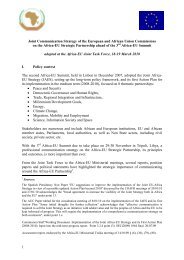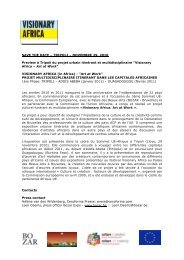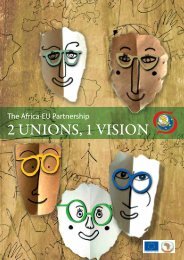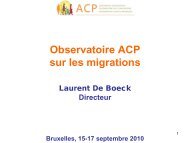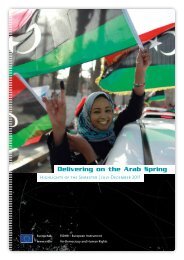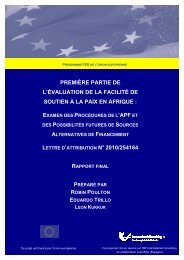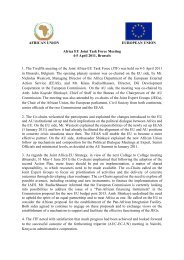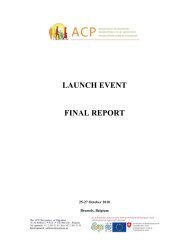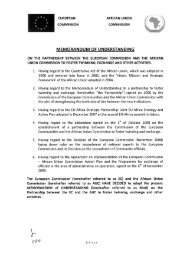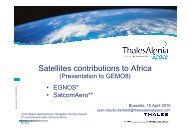part 1 of the african peace facility evaluation - European ...
part 1 of the african peace facility evaluation - European ...
part 1 of the african peace facility evaluation - European ...
You also want an ePaper? Increase the reach of your titles
YUMPU automatically turns print PDFs into web optimized ePapers that Google loves.
AU, <strong>the</strong> relative limited focus on <strong>the</strong> streng<strong>the</strong>ning <strong>of</strong> <strong>the</strong> AUC/RECs relation as a key driver <strong>of</strong> APSA,<br />
and <strong>the</strong> fragility <strong>of</strong> its political consensus keep APSA weak. Never<strong>the</strong>less, <strong>the</strong>re is no denying its<br />
importance, or <strong>the</strong> success <strong>of</strong> its first decade.<br />
At <strong>the</strong> same time, some <strong>of</strong> Africa’s regional organisations have also emerged as significant players in<br />
<strong>the</strong> field <strong>of</strong> <strong>peace</strong> and security. ECOWAS can claim success in Sierra Leone and Liberia, Niger and<br />
Guinea, and <strong>the</strong> 1998 Moratorium – now <strong>the</strong> legally binding Convention - on Small Arms is a seminal<br />
African experience. The MICOPAX intervention in Central African Republic is considered an ECCAS<br />
success. APSA’s success depends on <strong>the</strong> RECs and o<strong>the</strong>r regional structures, as well as <strong>the</strong> African<br />
Union. The notion <strong>of</strong> RECs as pillars <strong>of</strong> APSA is complicated by overlapping memberships, and<br />
differing roles in <strong>peace</strong> and security; and not all RECs are involved in <strong>the</strong> support to <strong>the</strong> African<br />
Standby Force 21 .<br />
Under <strong>the</strong> JAES, APF has evolved from a fund for PSOs, into <strong>the</strong> funding <strong>part</strong>ner <strong>of</strong> APSA 22 under <strong>the</strong><br />
logic and legal backing <strong>of</strong> <strong>the</strong> 2005 amended Cotonou Agreement; while APSA itself has <strong>the</strong> legal<br />
backing <strong>of</strong> <strong>the</strong> AU Constitutive Act and <strong>the</strong> AU Peace and Security Council. 23 Subsequent to <strong>the</strong> Paris<br />
Declaration on Aid Effectiveness <strong>of</strong> 25 March 2005, <strong>the</strong> JAES <strong>of</strong> 2007 sets out a new relationship<br />
between Africa and Europe based on a set <strong>of</strong> eight <strong>part</strong>nerships. The first <strong>of</strong> <strong>the</strong>se is <strong>the</strong> Peace and<br />
Security Partnership, under which APSA falls.<br />
APSA has ambitions that concern both conflict management and conflict prevention within and among<br />
African countries. The <strong>evaluation</strong> sees that it would be valuable to look more closely at African<br />
systems <strong>of</strong> ‘conflict management’, which are frequently discussed in <strong>the</strong> literature in connection with<br />
internal conflicts: <strong>the</strong> role <strong>of</strong> States, traditional authorities and civil society in reducing tensions and<br />
avoiding violence. Using this shorthand, APSA might be more effective and less costly, if ‘conflict<br />
management’ systems were supported at <strong>the</strong> local level: ‘Conflict prevention’ involving outsiders such<br />
as <strong>the</strong> REC, AU or international community would not be necessary. Such an approach, which makes<br />
sense as a complementary measure within <strong>the</strong> APF, would require that <strong>the</strong> APF and APSA be fully<br />
implemented in line with <strong>the</strong> human security doctrine 24 . Concretely, this would entail that APF<br />
contracts should be signed with o<strong>the</strong>r <strong>part</strong>ies than <strong>the</strong> AUC/RECs for such specific purposes and that<br />
a wider range <strong>of</strong> EU aid modalities are used in implementation <strong>of</strong> APF funds.<br />
APF has been fairly successful with low-cost interventions. In <strong>the</strong> conflict management area, <strong>the</strong> ERM<br />
stands out: 10 mediation missions were funded during 2010 and two additional during <strong>the</strong> first quarter<br />
<strong>of</strong> 2011, for no more than 6 months (<strong>the</strong> procedural maximum) and little cost. Using a ‘What If’<br />
hypo<strong>the</strong>sis for avoiding war, it is reasonable to surmise that several millions <strong>of</strong> Euros and <strong>the</strong> lives <strong>of</strong><br />
hundreds might have been saved through successful mediations in Guinea and Niger.<br />
Among PSO experiences, <strong>the</strong> two Comoros operations stand out as APF success stories: <strong>the</strong>y were<br />
short and effective, leaving <strong>the</strong> country stabilised after elections. On <strong>the</strong> o<strong>the</strong>r hand, synergy has been<br />
achieved on CB between APF and RIPs, as in <strong>the</strong> case <strong>of</strong> ECCAS, which has been very valuable to<br />
improve impact and avoid overlapping. The <strong>evaluation</strong> sees that an APF information and outreach<br />
strategy, disseminating Lessons Learned, could yield similar cost-effective benefits.<br />
21 The Arab Maghreb Union cooperating with Egypt was initially designated to act as <strong>the</strong> regional organisation<br />
which would create and support <strong>the</strong> brigade. For some time, intra-regional differences prevented any progress at<br />
all. However, a new mounting body, <strong>the</strong> North Africa Regional Capability, has now been created to take on <strong>the</strong><br />
role <strong>of</strong> <strong>the</strong> REC for Nor<strong>the</strong>rn Africa<br />
22 For this evolution see tables in <strong>the</strong> Executive Summary sections 1.1 and 1.2 above.<br />
23 APSA’s structure is outlined in The Protocol Relating to <strong>the</strong> Establishment <strong>of</strong> <strong>the</strong> Peace and Security Council<br />
Adopted by <strong>the</strong> 1st Ordinary Session <strong>of</strong> <strong>the</strong> Assembly <strong>of</strong> <strong>the</strong> African Union in Durban, 9 July 2002<br />
24 The Barcelona Report “A Human Security Doctrine for Europe”, presented by <strong>the</strong> EU High Representative for<br />
Common Foreign and Security Policy, Javier Solana, in September 2004.<br />
Page 13 <strong>of</strong> 49




